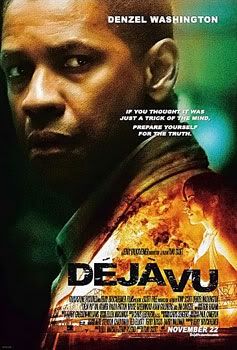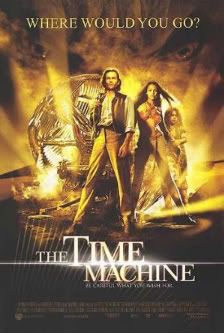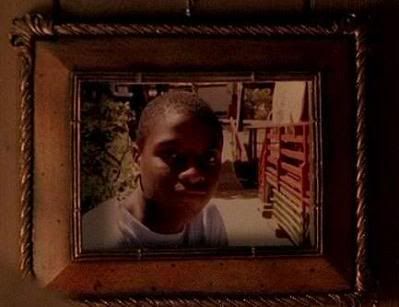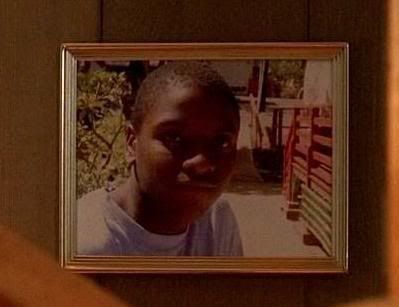Are you all everybody ready to get a little whackadoo?

Since the Season 5 finale, I've wondered why Ilana's team of chosen ones brought Locke's body to the Cabin. Why didn't they proceed directly to the Foot, where the "shadow of the statue" riddle suggests Jacob can be found? And why did the corporeal Jacob need Locke's body in the first place? These questions had me stumped, until I reconsidered a possibility that several of you raised after the finale. What if "Jacob's Cabin" actually belonged to the Man in Black?

After the Man Behind the Curtain, I guessed that Jacob's ghost was imprisoned in the Cabin. This seems wrong now that we've seen him moving around freely off the Island. But whoever lived there clearly needed a body, so what about the Man in Black? He hasn't taken that form since his talk on the beach with Jacob. And the ghost in the chair sure resembles Silas Adams, a character from Deadwood played by Titus Welliver, the actor who also plays the Man in Black.

So why were Ilana and Co. bringing a body to the Man in Black? It's possible they're his pawns, but recall my speculation in Three Black Swans that Jacob wanted the Man in Black to find his Loophole. I think Jacob tapped Ilana to lead the dangerous mission of hand delivering the corpse in a box to help the Man in Black escape. When she found the ash circle broken and the Cabin empty, she correctly surmised that the Man in Black had already found an exit.

I believe the Man in Black escaped by temporarily possessing his faithful dog Cerberus. Their master-pet relationship is symbolized by Cerberus's canine name, the dog painting in the Cabin, and (ironically) Zombie Christian commanding Vincent the dog to wake up Jack. The relief carving of dog-headed Anubis feeding the smoke monster (yet another ironic reference to their relationship) suggests the Man in Black uses dead souls as Scooby Snacks.

Master and pet were reunited the same night Hurley stumbled upon the Cabin. The two figures he spied therein were Cerberus and the Man in Black. Somehow, maybe even with Jacob's help, the Cabin moved outside the ash circle, which previously kept Cerberus at bay like the sonic fence around the Barracks. The Man in Black then possessed Cerberus and walked out of the Cabin as Zombie Christian. The change in Christian's clothing symbolizes this possession.
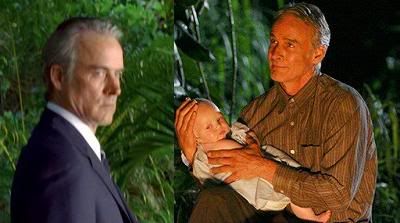
Once the Cabin moved back inside the circle, however, the Man in Black was locked out by his union with Ceberus. Claire was his literal and figurative key to reentry. The Man in Black used her to break the circle so he could get back into the Cabin and claim to speak for Jacob when Locke sought directions in Cabin Fever, thereby initiating the Loophole. Claire eventually realized the truth and resisted her captor, making the mess that Ilana finds at the Cabin.

I suspect Jon G is correct that the ash circle is actually the remains of the statue of Taweret. It was destroyed some time after the Black Rock's arrival, probably by dynamite from the ship's hold. The same magic that kept Cerberus out of the Foot also prevented it from entering the Cabin. I'm guessing this will all be shown in a flashback that also reveals Richard Alpert killed the Man in Black, perhaps in the same explosion that destroyed the statue.

Richard's longevity wasn't so much a reward as a sign of Jacob's trust. He became a permanent firewall between Jacob and the Others. Remember how the Tapestry seemed to surprise Ben? That's because it was his first time inside the Foot -- and for good reason. Ben's loss of "innocence" to Cerberus as a child connected him with the Man in Black, who became privy to everything Ben knew. No wonder Jacob never spoke directly with Ben.

For decades, Jacob communicated with his people solely through lists. And that raises one last whackadoo speculation for you all everybody to consider. Remember how Other Tom mentioned that Jack wasn't on Jacob's list? Mikhail said something similar about Kate and Sayid. Based on the foregoing, I believe the omissions were deliberate. Jacob wanted to keep their identities a secret from his nemesis until the last possible moment.
UPDATE: August 31, 2009
Many of you were understandably skeptical that Jacob chose Ilana to bring the Man in Black a body. And you're right that it's more likely she was -- as she says -- bringing the corpse "to show it to somebody" -- presumably Richard -- "so they'll know what they're up against." But Ilana and Bram also discussed the possibility of Frank being a "candidate." I think it's still possible, albeit less likely, that Lapidus and Locke were both potential "candidates" for the Man in Black to inhabit.
I can imagine Jacob telling Ilana: "You're my insurance policy. I'm planning to let the Man in Black escape to help facilitate his Loophole. But there's a very good chance fate will frustrate my plans. So I need you to bring a body to the Cabin in case my gambit fails." When Ilana saw Locke both alive and dead, she suspected that the Man in Black had already reincarnated himself. But she brought Locke (and Lapidus) to the Cabin just to be sure, before taking his body to Richard.
That brings me to another excellent question that several of you raised: how did Ben come to erroneously associate the Cabin with Jacob? I think the simplest answer is that Richard unwittingly misled him. If Alpert killed the Man in Black, he probably helped imprison the latter in the Cabin as well. Jacob may occasionally have needed to communicate with his nemesis and used Richard as a message bearer. Maybe Ben followed Alpert during one such trip to the Cabin.
But if you really want to follow me down the whackadoo well, consider the possibility that Richard deliberately deceived Ben. All it would take to arouse the latter's curiosity would be a warning to stay away from Jacob's forbidden Cabin of mysteries. Particularly for a little boy, the fascination would no doubt prove irresistible. I could even see Jacob ordering Richard to encourage Ben's relationship with the Man in Black to facilitate the Loophole.
Nor would it surprise me if the Others turned out to be pawns in Jacob's long con of the Man in Black as well. Richard equates Ben's loss of "his innocence" with becoming "one of us," implying the Others are all connected to some degree with Cerberus. So, what if the Others were always just a diversion to distract the Man in Black from Jacob's real game, which involves off-Island pieces like Ilana and Jack? Perhaps those primitive costumes and that decoy village are really metaphors for the Others themselves...

Since the Season 5 finale, I've wondered why Ilana's team of chosen ones brought Locke's body to the Cabin. Why didn't they proceed directly to the Foot, where the "shadow of the statue" riddle suggests Jacob can be found? And why did the corporeal Jacob need Locke's body in the first place? These questions had me stumped, until I reconsidered a possibility that several of you raised after the finale. What if "Jacob's Cabin" actually belonged to the Man in Black?

After the Man Behind the Curtain, I guessed that Jacob's ghost was imprisoned in the Cabin. This seems wrong now that we've seen him moving around freely off the Island. But whoever lived there clearly needed a body, so what about the Man in Black? He hasn't taken that form since his talk on the beach with Jacob. And the ghost in the chair sure resembles Silas Adams, a character from Deadwood played by Titus Welliver, the actor who also plays the Man in Black.

So why were Ilana and Co. bringing a body to the Man in Black? It's possible they're his pawns, but recall my speculation in Three Black Swans that Jacob wanted the Man in Black to find his Loophole. I think Jacob tapped Ilana to lead the dangerous mission of hand delivering the corpse in a box to help the Man in Black escape. When she found the ash circle broken and the Cabin empty, she correctly surmised that the Man in Black had already found an exit.

I believe the Man in Black escaped by temporarily possessing his faithful dog Cerberus. Their master-pet relationship is symbolized by Cerberus's canine name, the dog painting in the Cabin, and (ironically) Zombie Christian commanding Vincent the dog to wake up Jack. The relief carving of dog-headed Anubis feeding the smoke monster (yet another ironic reference to their relationship) suggests the Man in Black uses dead souls as Scooby Snacks.

Master and pet were reunited the same night Hurley stumbled upon the Cabin. The two figures he spied therein were Cerberus and the Man in Black. Somehow, maybe even with Jacob's help, the Cabin moved outside the ash circle, which previously kept Cerberus at bay like the sonic fence around the Barracks. The Man in Black then possessed Cerberus and walked out of the Cabin as Zombie Christian. The change in Christian's clothing symbolizes this possession.

Once the Cabin moved back inside the circle, however, the Man in Black was locked out by his union with Ceberus. Claire was his literal and figurative key to reentry. The Man in Black used her to break the circle so he could get back into the Cabin and claim to speak for Jacob when Locke sought directions in Cabin Fever, thereby initiating the Loophole. Claire eventually realized the truth and resisted her captor, making the mess that Ilana finds at the Cabin.

I suspect Jon G is correct that the ash circle is actually the remains of the statue of Taweret. It was destroyed some time after the Black Rock's arrival, probably by dynamite from the ship's hold. The same magic that kept Cerberus out of the Foot also prevented it from entering the Cabin. I'm guessing this will all be shown in a flashback that also reveals Richard Alpert killed the Man in Black, perhaps in the same explosion that destroyed the statue.

Richard's longevity wasn't so much a reward as a sign of Jacob's trust. He became a permanent firewall between Jacob and the Others. Remember how the Tapestry seemed to surprise Ben? That's because it was his first time inside the Foot -- and for good reason. Ben's loss of "innocence" to Cerberus as a child connected him with the Man in Black, who became privy to everything Ben knew. No wonder Jacob never spoke directly with Ben.

For decades, Jacob communicated with his people solely through lists. And that raises one last whackadoo speculation for you all everybody to consider. Remember how Other Tom mentioned that Jack wasn't on Jacob's list? Mikhail said something similar about Kate and Sayid. Based on the foregoing, I believe the omissions were deliberate. Jacob wanted to keep their identities a secret from his nemesis until the last possible moment.
UPDATE: August 31, 2009
Many of you were understandably skeptical that Jacob chose Ilana to bring the Man in Black a body. And you're right that it's more likely she was -- as she says -- bringing the corpse "to show it to somebody" -- presumably Richard -- "so they'll know what they're up against." But Ilana and Bram also discussed the possibility of Frank being a "candidate." I think it's still possible, albeit less likely, that Lapidus and Locke were both potential "candidates" for the Man in Black to inhabit.
I can imagine Jacob telling Ilana: "You're my insurance policy. I'm planning to let the Man in Black escape to help facilitate his Loophole. But there's a very good chance fate will frustrate my plans. So I need you to bring a body to the Cabin in case my gambit fails." When Ilana saw Locke both alive and dead, she suspected that the Man in Black had already reincarnated himself. But she brought Locke (and Lapidus) to the Cabin just to be sure, before taking his body to Richard.
That brings me to another excellent question that several of you raised: how did Ben come to erroneously associate the Cabin with Jacob? I think the simplest answer is that Richard unwittingly misled him. If Alpert killed the Man in Black, he probably helped imprison the latter in the Cabin as well. Jacob may occasionally have needed to communicate with his nemesis and used Richard as a message bearer. Maybe Ben followed Alpert during one such trip to the Cabin.
But if you really want to follow me down the whackadoo well, consider the possibility that Richard deliberately deceived Ben. All it would take to arouse the latter's curiosity would be a warning to stay away from Jacob's forbidden Cabin of mysteries. Particularly for a little boy, the fascination would no doubt prove irresistible. I could even see Jacob ordering Richard to encourage Ben's relationship with the Man in Black to facilitate the Loophole.
Nor would it surprise me if the Others turned out to be pawns in Jacob's long con of the Man in Black as well. Richard equates Ben's loss of "his innocence" with becoming "one of us," implying the Others are all connected to some degree with Cerberus. So, what if the Others were always just a diversion to distract the Man in Black from Jacob's real game, which involves off-Island pieces like Ilana and Jack? Perhaps those primitive costumes and that decoy village are really metaphors for the Others themselves...

